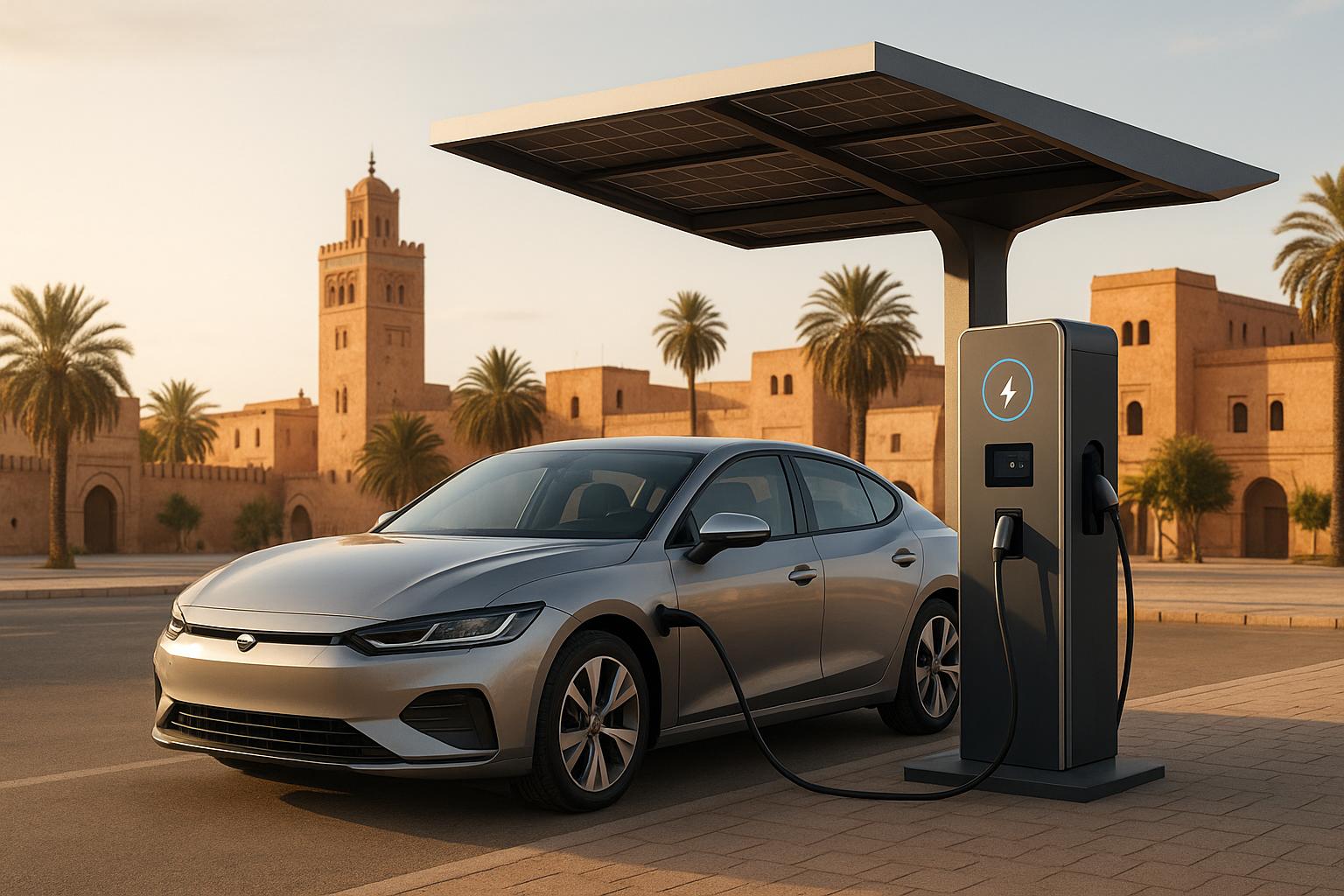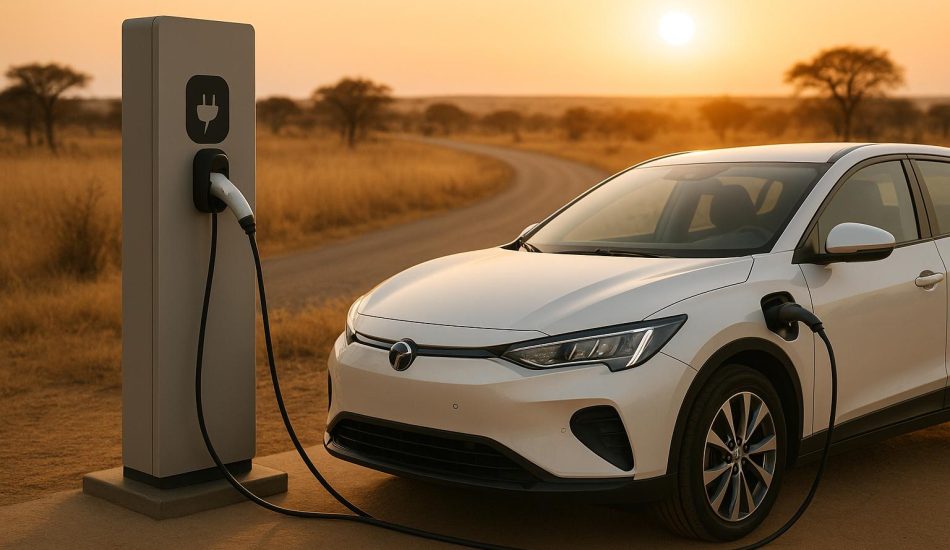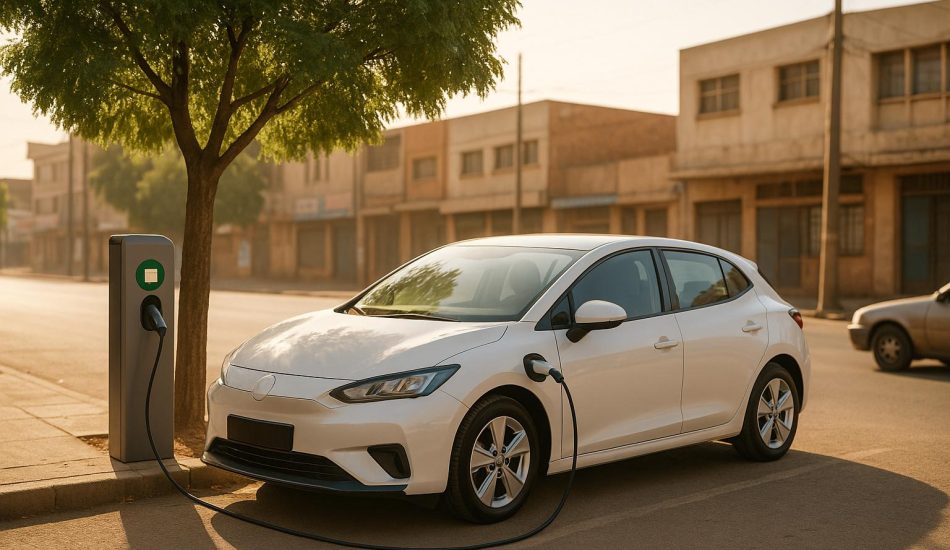
Electric vehicles (EVs) in Morocco offer long-term savings on fuel and maintenance, thanks to lower electricity costs and reduced upkeep compared to gas-powered cars. However, the decision to invest in an EV depends on your driving habits, access to charging infrastructure, and budget.
Here’s the key takeaway:
- Costs: EVs range from $5,880 for entry-level models to $34,700 for premium options. Local production, like Neo Motors‘ upcoming city EV, aims to lower costs further.
- Incentives: Morocco waives customs duties, VAT, and most fees for fully electric cars meeting specific criteria, making ownership more affordable.
- Charging Network: With 300+ public chargers and plans to expand to 5,000 by 2028, urban areas are well-covered, but rural regions still face challenges.
- Performance: EVs excel in cities with shorter commutes but require careful planning for long-distance travel due to limited rural charging stations.
- Savings: Electricity costs are lower than gasoline, and EVs need less maintenance, offering financial benefits over time.
For urban drivers with reliable access to charging, EVs are practical and cost-effective. For rural or long-distance drivers, infrastructure gaps may limit convenience. Evaluate your needs and local infrastructure before deciding.
Electric Cars : Morocco’s Bright Future!
EV Costs and Financial Support in Morocco
Understanding the costs of electric vehicles (EVs) in Morocco involves balancing their purchase prices with the financial support available from the government. Below, we break down the key aspects: pricing, government incentives, and financing options.
EV Purchase Prices in Morocco
Electric vehicle prices in Morocco cover a wide range, catering to different budgets and preferences. For example:
- Entry-level models like the GEELY PANDA MINI BASE are priced at about $5,880.
- Mid-range options such as the BYD DOLPHIN ACTIVE cost around $11,800.
- Premium models like the BYD TANG EV 2024 can go up to approximately $34,700.
The BYD Seagull, priced at 209,900 MAD (around $20,990 USD), offers a range of 445 km (276 miles) per charge. Morocco is also stepping into EV production with Neo Motors, which plans to introduce a city-focused electric car in 2026 for around 100,000 MAD (roughly $11,000). This local production aims to bypass import costs, making EVs more accessible to urban drivers.
To put this into perspective, for a $34,000 EV that meets all technical criteria, the total cost after incentives could be as low as $34,835. This includes just $835 in administrative and parafiscal fees, a stark contrast to the $13,750 in taxes and fees typically associated with a conventional car of similar value.
Government Support Programs
The Moroccan government has taken steps to encourage EV adoption, focusing on tax and duty reductions rather than direct subsidies. Historically, high import duties and taxes inflated vehicle prices in the country. Now, qualifying electric vehicles benefit from:
- Eliminated customs duties
- Exemptions from VAT
- Minimal administrative fees
However, these benefits are strictly for fully electric vehicles that meet specific requirements, including minimum battery capacity and proper documentation. Necessary paperwork includes a Certificate of Conformity and environmental compliance certificates. Without these, buyers lose access to the incentives.
Financing Options for Buyers
To make EV ownership more attainable, financing options have become more flexible. Traditional banks are now offering auto loans designed specifically for EV purchases, with terms varying based on an applicant’s credit profile. Platforms like EV24.africa simplify the import process by offering structured payment plans, reducing the financial strain of upfront costs.
Additionally, dealerships representing major brands such as BYD, MG, and Citroën often collaborate with local banks to provide attractive financing packages. These deals sometimes include perks like extended warranties or maintenance plans, further enhancing the appeal of EV ownership.
Together, these factors are driving the rapid adoption of EVs in Morocco. Electric and hybrid vehicles now make up 5% of new car sales, and this figure is expected to double within the next two years. When considering an EV, it’s crucial to assess the total cost of ownership – including the purchase price, available incentives, and financing options – to determine if it aligns with your financial and lifestyle needs.
Charging Infrastructure and Daily Use in Morocco
The daily usability of electric vehicles (EVs) in Morocco is closely tied to the state of its charging infrastructure. While the country has made strides in expanding its network, EV owners still encounter several practical challenges that influence their day-to-day experiences.
Current Charging Network Status
Morocco’s charging infrastructure has seen notable growth, with over 300 public charging points operational as of 2025. The network consists of approximately 1,500 AC (Alternating Current) charging stations and around 100 DC (Direct Current) fast-charging stations. AC stations typically offer power outputs ranging from 7.11 to 22 kilowatts (kW), while DC stations provide faster charging speeds between 50 and 180 kW.
Most of these public chargers, especially Level 2 units, are concentrated in major cities like Casablanca, Rabat, and Marrakech. DC fast chargers are generally found at gas stations, while AC chargers are more versatile and can be installed in homes, hotels, and commercial spaces.
Morocco is making significant investments to expand this network. In 2023, local companies announced a $140 million plan to install 5,000 charging stations by 2028, prioritizing public locations and highways. This initiative is supported by private operators like Chargemap and government-backed efforts involving companies such as Schneider Electric and other local players. Additionally, the government has set a goal to establish 2,500 new public charging points by 2026.
Currently, Morocco boasts a ratio of 8 EVs per public charger, which is better than the global average of 10 EVs per charger. This indicates that the infrastructure is keeping pace with EV adoption. However, despite these advancements, EV owners still face challenges in their daily routines.
Daily Challenges for EV Owners
EV users in Morocco encounter several hurdles that affect their driving experience. One of the biggest issues is the uneven distribution of charging stations, as the network is heavily concentrated in urban areas. This leaves rural regions with limited access, creating range anxiety for drivers traveling between cities.
For urban residents, charging is generally more convenient, with most relying on home or workplace chargers. However, individuals living in apartments or older buildings without dedicated parking spaces face difficulties in installing home chargers, making them more dependent on public infrastructure.
Charging time is another factor. While DC fast chargers can add significant range in 30–60 minutes, AC chargers require several hours to fully charge a vehicle. This means EV owners need to plan their charging sessions around other activities, which is quite different from the quick 5-minute refueling experience at a gas station.
For those venturing beyond city limits, the lack of rural charging stations adds complexity to trip planning. Drivers must carefully map out their routes to ensure access to chargers, a challenge that doesn’t exist with traditional gas-powered vehicles.
EV Charging vs Gas Station Comparison
These challenges highlight the differences between EV charging and traditional gas refueling:
| Feature | EV Charging | Gas Refueling |
|---|---|---|
| Network Availability | Concentrated in cities; limited in rural areas | Extensive coverage in both urban and rural areas |
| Time Required | 30–60 minutes (DC fast charging), 4–8 hours (AC charging) | 3–5 minutes |
| Cost per Mile | Lower due to electricity rates | Higher due to gasoline prices and taxes |
| Range Anxiety | Present for intercity travel due to limited rural charging | Minimal, thanks to widespread availability |
| Convenience | Requires planning, especially for long trips | Readily available with little planning |
To address these gaps, the Ministry of Energy Transition and Sustainable Development is promoting a "Green Charging Network", aiming to ensure EV infrastructure is accessible nationwide. Projects like Green Energy Park are working to establish charging corridors along Morocco’s major highways, further supporting intercity travel.
For prospective EV buyers exploring platforms like EV24.africa, understanding the current state of charging infrastructure is essential. Urban dwellers with access to home charging will find EV ownership more convenient, while those relying on public chargers may face additional hurdles. However, as Morocco continues its push to meet the 5,000-station target by 2028, many of these challenges are expected to ease over time.
Long-Term Cost Savings with EVs
Owning an electric vehicle (EV) in Morocco offers a chance to save money over time, thanks to lower energy costs, reduced maintenance needs, and solid resale potential.
Electricity vs. Gasoline Costs
Morocco’s push toward renewable energy is evident in initiatives like green electricity subsidies. For instance, foreign companies can benefit from electricity rates as low as $0.02 per kilowatt-hour (kWh). With the country investing heavily in solar and wind power, EV charging costs are likely to remain affordable and stable. These lower energy expenses, combined with reduced maintenance requirements, make EVs an attractive option for cost-conscious drivers.
Lower Maintenance Costs
Electric vehicles are mechanically simpler than gasoline-powered cars, which translates to fewer maintenance headaches. Routine services like tire rotations, cabin air filter replacements, and occasional brake fluid changes are less demanding compared to the frequent oil changes and other upkeep required for internal combustion engines. Plus, many EV manufacturers back their vehicles with battery warranties, offering peace of mind and reducing long-term ownership costs. These savings also contribute to better resale value when it’s time to upgrade.
EV Resale Values in Morocco
As Morocco’s EV market matures, early adopters are poised to benefit from strong resale values. The growing network of charging stations and supportive government policies are driving demand for pre-owned EVs. Additionally, improvements in battery technology and market dynamics could shape resale prices in the coming years. For those browsing platforms like EV24.africa, choosing models with robust manufacturer support can help ensure a better return on investment down the road.
sbb-itb-99e19e3
Policy and Climate Impact of EVs
Morocco’s push for sustainability and energy independence positions electric vehicles (EVs) as a smart, forward-thinking investment. The nation has committed to ambitious greenhouse gas reduction targets as part of its global climate agreements. EVs play a pivotal role in this effort by significantly reducing tailpipe emissions – an impact that’s especially meaningful in Morocco’s bustling urban centers. These environmental goals are closely tied to the country’s growing focus on renewable energy.
From expansive solar farms to wind power initiatives, Morocco is steadily building a cleaner, greener electric grid. As renewable energy becomes a larger part of the mix, the environmental benefits of EVs will only deepen, offering a cleaner alternative to traditional gasoline-powered vehicles.
On the economic front, the Moroccan government is actively shaping a thriving EV ecosystem. Through policies that simplify adoption, incentives that make EVs more accessible, and international partnerships, the country is bolstering local EV manufacturing, infrastructure development, and workforce expertise. These efforts not only cut emissions but also strengthen the economic case for EVs, paving the way for long-term benefits.
How EVs Handle Morocco’s Driving Conditions
Understanding how electric vehicles (EVs) perform in Morocco is key to evaluating their value as a long-term investment. With its diverse geography and climate, Morocco presents unique challenges and opportunities for EV adoption. Let’s explore how these factors impact EV performance across the country.
Geography and Weather Effects on EVs
Morocco’s varied landscape includes everything from coastal plains to the rugged Atlas Mountains and expansive desert regions. This diversity directly affects how EVs operate:
- Mountainous Terrain: Driving in areas like the Atlas Mountains demands more energy during uphill climbs. However, EVs can recover some of this energy through regenerative braking on the way down, partially offsetting the increased energy use.
- Climate Impact: Coastal cities with moderate climates provide ideal conditions for consistent EV performance. On the other hand, extreme heat in desert regions or cooler temperatures in higher altitudes can impact battery efficiency, requiring careful planning for longer trips. Dust and sand in desert areas also emphasize the need for regular maintenance to keep EVs running smoothly.
Geography and climate are just one side of the equation. Daily driving conditions – whether in bustling cities or quieter rural areas – play an equally important role in shaping EV performance.
City vs. Rural EV Performance
Driving patterns and infrastructure availability differ significantly between urban and rural areas, which influences how practical EVs are in each setting.
Urban Performance:
Cities like Marrakech, Casablanca, and Fez are well-suited for EVs. Their quick acceleration, regenerative braking, and compatibility with stop-and-go traffic make them a great choice for urban driving. Additionally, Morocco’s growing charging network supports city drivers. By November 2025, about 1,000 charging stations had been installed in major urban centers, offering both public and home charging options.
Rural Challenges:
In rural areas, EV adoption faces more hurdles. Charging infrastructure is still limited, and the longer distances between destinations can strain an EV’s range. However, government plans to add 2,500 new charging stations by 2026 offer hope for better rural coverage. For now, rural drivers need to carefully consider these limitations when deciding whether an EV fits their lifestyle.
Ultimately, the practicality of owning an EV in Morocco depends on where and how you plan to drive. City dwellers benefit from established charging networks and shorter commutes, while rural drivers must weigh current infrastructure gaps against planned expansions. These factors, combined with costs and other practical considerations, are crucial when deciding if an EV is the right choice in Morocco.
Final Assessment: EVs as an Investment in Morocco
When weighing the potential of electric vehicles (EVs) as an investment in Morocco, it’s essential to consider your driving habits and the availability of charging infrastructure in your area. While the decision isn’t cut-and-dried, understanding how cost, charging access, and driving patterns intersect can help clarify whether an EV is the right choice for you.
EVs typically come with a higher upfront price tag, but they can offset this with long-term savings on fuel and maintenance. For those whose daily commutes are primarily within urban areas – and who have access to charging at home or work – EVs can be a practical and cost-effective option. Major cities in Morocco, for example, offer around 1,000 charging stations, making it easier for city drivers to incorporate EVs into their routine.
On the other hand, if you frequently travel long distances or live in a region with limited charging infrastructure, the benefits of owning an EV may diminish. Sparse charging options and extended travel distances could make EV ownership less convenient and potentially more costly.
Ultimately, the key is to assess your daily driving habits and the availability of local charging stations to determine if an EV aligns with your financial and practical goals.
FAQs
What financial incentives are available for electric car buyers in Morocco?
Electric car buyers in Morocco enjoy a range of financial perks that make switching to electric vehicles more appealing. These include reduced import duties, lower VAT rates, and discounted registration fees. These measures aim to lower the upfront costs of electric vehicles and promote their adoption across the country.
On top of that, electric vehicles offer substantial long-term savings. With lower fuel expenses and reduced maintenance needs compared to traditional cars, they present an attractive option for those looking to save money while making an eco-friendly choice.
What is the current state of charging infrastructure in Morocco, and how does it differ between cities and rural areas?
Morocco’s network of charging stations is steadily expanding, with most of the infrastructure currently centered in urban hubs and major highways. Cities such as Casablanca and Rabat are setting the pace, offering more accessible charging options. However, rural areas still lag behind, with fewer facilities available.
To address this imbalance, both the Moroccan government and private companies are actively working to broaden the network. Their efforts include introducing more fast-charging stations, aiming to make charging easier and encourage the growing use of electric vehicles nationwide.
How much money can you save by owning an electric car in Morocco compared to a gas-powered car?
Owning an electric vehicle (EV) in Morocco can be a smart financial decision, offering long-term savings compared to traditional gas-powered cars. One of the biggest advantages is the lower operating costs. Electricity tends to be cheaper than gasoline, and EVs require less maintenance since they have fewer moving parts. This means less wear, fewer repairs, and reduced upkeep expenses.
On top of that, Morocco provides government incentives like tax exemptions or reduced import duties, which can help lower the upfront cost of purchasing an EV. When you combine these financial perks with the added benefit of reducing environmental impact, it’s clear why EVs are becoming an appealing choice for drivers in the region.




